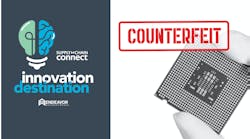Managing Excess Inventory and Protecting Your Obsolete and End-of-Life Parts
The implications of managing excess inventory have changed over the years. Excess material from different programs or discontinued products can often be placed in overstock or residual areas of the stockroom. Decisions may be made to sell or scrap-out the excess to independent distributors or brokers. Some of the options for handling the excess inventory include virtual consignment, physical consignment, barter or trade, outright sales, or donating to a qualified source for a tax beneficial reason. Here’s a look at each option:
- Virtual consignment allows you to keep your excess at your facility and post what you want to sell through your independent distributor on the Internet for sale. The disadvantages are that you must respond to sales quickly when the independent sells the parts, which could cause frequent interruptions to your business. What’s more, you could lose the sale if you don’t respond in a timely manner. In addition, you must update the independent distributor frequently on inventory levels due to changes in parts status.
- Physical consignment offers one of the best values for your excess. Most consignment agreements offer a 75/25 split, meaning you receive 75% of the sale price of your excess inventory through an independent distributor (the percentages can be negotiated). The excess is shipped to the independent distributor and held in a secure area. Once the inventory has been inspected for counterfeit parts and counts are verified, a list is created and posted on the Internet for sale. A statement of sales and a check are sent out quarterly.
- Barter or trade usually involves considerable excess electronics being sold in exchange for components the independent has for your future requirements. The problem is, the lot your selling is being cherry picked for the high-end components and very little value is given to the balance of the lot.
- Outright sale has been a popular way for most companies to dispose of their excess in the past. This method offers a fast and convenient means for selling a large lot of excess electronics. Generally speaking, you generate a list of parts, with quantities and standard cost, and the independent distributor bids on the lot. The drawback is that the independent distributor can only guess on the forecasted sale value of the lot and will only offer a small percentage of the value of the lot.
- Donating to a qualified source for a tax benefit. You often hear radio ads to donate your car and receive a tax benefit and help out a needy charity. This is a similar situation. But again, the problem is much like outright sale or trade: only a small percentage is offered for the lot of excess because its value is unknown.
Physical consignment programs offer the best bang for your buck in my opinion. Many independent distributors offer excess programs with the ability to retrieve your obsolete inventory when needed.
First, the excess inventory must be counted and part numbers verified and inspected for counterfeit components. Counterfeit may have made its way in through excess returned from contract manufacturers or parts received before proper counterfeit inspection or improved methods of inspecting were in place. If unable to inspect for counterfeit in house, the independent distributor can screen when receiving incoming excess. The excess list can then be scrubbed/screened for obsolescence through a variety of software programs. Many distributors offer this service. Taudhe preferred way would be to screen for obsolete parts before the excess is shipped, then the parts that are obsolete or near end-of-life can be saved in case discontinued products need to be brought back for new sales or for use in spares and repairs. Often, components used in one assembly are sold over multiple contracts; reviewing excess or residual inventory by contracts is suggested. Combing all the excess from other divisions and sharing excess can diminish the amount of times each division is purchasing in the outside market.
Maximizing the excess inventory options that incur no cost to your company and capitalizing on sales and re-utilization of material can add value to your bottom line and keep buyers from procuring material from the outside market.







